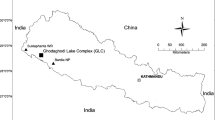Abstract
The Rudrasagar Lake is a famous tourist spot in northeast India owing to the presence of the Neermahal Palace within it. Unfortunately, growing human intervention within its catchment area has led to its gradual degradation and areal shrinkage. Thus the current analysis seeks to assess the various geo-environmental problems that accrue in the area surrounding the Rudrasagar Lake and their impacts. Four cross sections were taken across the connecting channels. Land use land cover (LULC) change within a 1 km buffer zone around this lake over a 30-year period (1988–2018) was analyzed. The USLE model was used to identify the nature of soil loss from the lake catchment. A household survey was conducted to identify the issues stemming from the degradation of the lake. The study reveals a significant increase in settled and agricultural land within the immediate surroundings of this lake during the period 1988–2018. Moreover, the area under moderate, high, very high, and severe soil loss within the Rudrasagar Lake catchment has increased manifold within the last few decades. It has accelerated the problem of siltation in this lake. Nearly 89% of the surveyed respondents felt that fish production from this lake had gradually decreased causing a section of the local fishermen to shift their occupation partially or completely.
Access this chapter
Tax calculation will be finalised at checkout
Purchases are for personal use only
Similar content being viewed by others
References
Abir S (2014) Seasonal variations in Physico-chemical Cherracteristics of Rudrasagar Wetland—a Ramsar Site, Tripura, North East. India. Res J Chem Sci 4(1):31–40
Barman D, Mandal SC, Bhattacharjee P, Datta SP (2013) Status of Rudrasagar Lake (Ramsar Site) in Tripura. India. Environ Ecol 31(3):1320–1325
Choudhury AU (2008) Rudrasagar “A Potential IBA in Tripura in North-East India.” Mistnet 9:4–5
Dabral PP, Baithuri N, Pandey A (2008) Soil erosion assessment in a hilly catchment of North Eastern India using USLE, GIS and remote sensing. Water Resour Manag 22:1783–1798
Deka S (2010) Conservation, restoration and management of Rudrasagar Lake (Tripura), Seminar proceedings, department of life science, Dibrugarh University
Durmaz F, Karakaya N, Evrendilek F (2016) Spatiotemporal change detection analysis of Turkish lake water surface area in response to anthropogenic ecosystem disturbances using long-term Landsat TM/ETM+ Data. J Ecosys Ecograph 6(2):188. https://doi.org/10.4172/2157.7625.1000188
Madhumathi T, Sharon Bercy J, Thangaperumal S (2018) Water quality assessment of Velacherry Lake using remote sensing and GIS techniques. Int J Sci Res 7(3):159–165. https://doi.org/10.21275/3031801
Maurya AK, Radhakrishnan KV, Kumar R (2020) Population characteristics and level of exploitation of Anabas testudineus (Bloch, 1792) in Rudrasagar Lake, a Ramsar site in North-eastern India. Indian J Mar Sci 49(2):298–302
Pal J, Pal M, Roy PK, Mazumdar A (2016) Quantitative assessment of water of Rudrasagar Lake, Tripura. India. Eur J Adv Eng Tech 3(3):45–48
Pal M, Samal NR, Roy MB, Roy PK (2015) Water quality index as a reliable indicator of water pollution level-A case study of Rudrasagar Lake, Tripura. Int J Innov Res Sci Eng Technol 4(8):7801–7806. https://doi.org/10.15680/IJIRSET.2015.0408138
Prasannakumar V, Vijith H, Abinod S, Geeth N (2012) Estimation of soil erosion risk within a small mountainous sub–watershed in Kerala, India, using revised universal soil loss equation (RUSLE) and geo–information technology. Geosci Front 3(2):209–215
Saraf M, Nair SJ (2015) Restoration and conservation of urban lakes. Int J Adv Eng Res Dev 2(6):315–323
Author information
Authors and Affiliations
Corresponding author
Editor information
Editors and Affiliations
Rights and permissions
Copyright information
© 2022 The Author(s), under exclusive license to Springer Nature Switzerland AG
About this chapter
Cite this chapter
Ahmed, I., Das (Pan), N., Debnath, J., Banik, H. (2022). Geo-Environmental Problems in the Fringe Areas of the Rudrasagar Lake, Tripura, India. In: Saikia, A., Thapa, P. (eds) Environmental Change in South Asia. Springer, Cham. https://doi.org/10.1007/978-3-030-47660-1_12
Download citation
DOI: https://doi.org/10.1007/978-3-030-47660-1_12
Published:
Publisher Name: Springer, Cham
Print ISBN: 978-3-030-47659-5
Online ISBN: 978-3-030-47660-1
eBook Packages: Biomedical and Life SciencesBiomedical and Life Sciences (R0)




